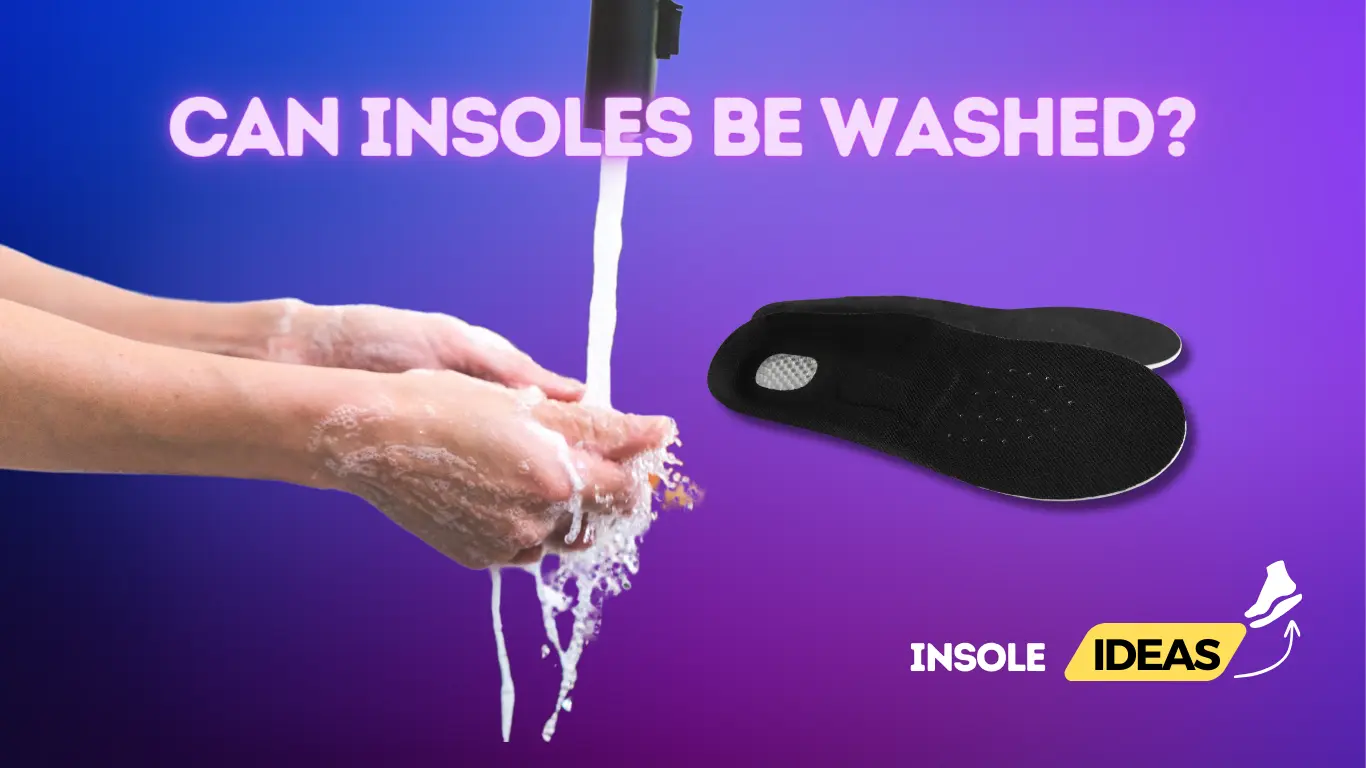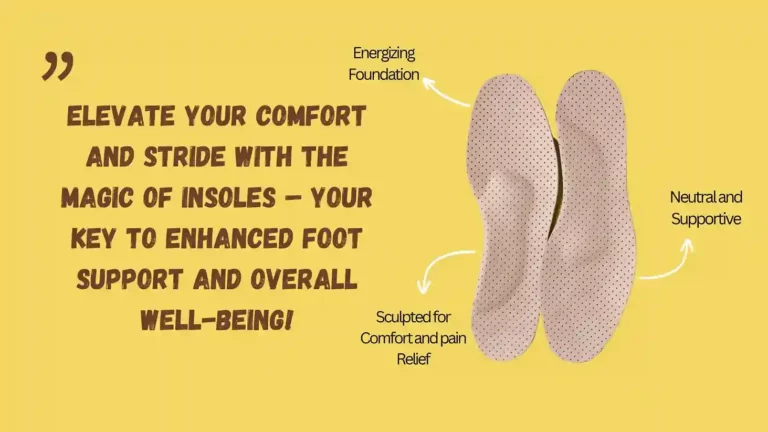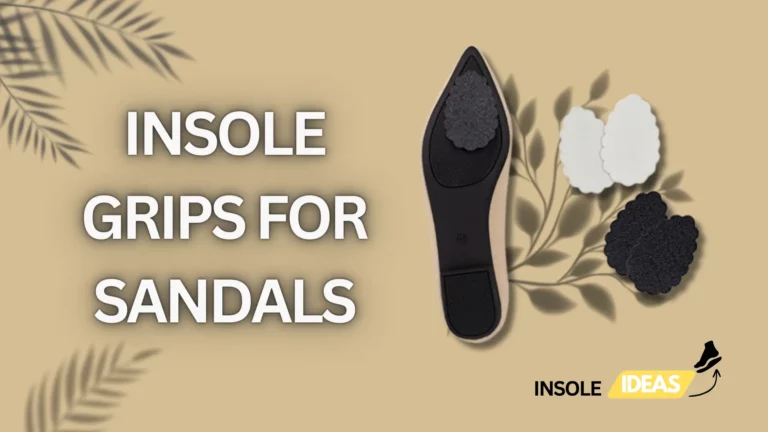Can Insoles Be Washed? A Complete Guide
Insoles are an essential component of footwear designed to provide additional comfort, support, and cushioning to the feet. They serve as a barrier between the foot and the shoe, absorbing impact, reducing friction, and preventing foot fatigue. Understanding how to care for your insoles, including whether they can be washed, is crucial for maintaining hygiene and prolonging their lifespan.
Definition of Insoles
Insoles, also known as footbeds or inner soles, are inserts placed inside shoes to enhance comfort and support. They come in various shapes, sizes, and materials to accommodate different foot types and footwear styles. Insoles can be removable or built into the shoe, offering customization options for individuals with specific foot conditions or preferences.
Importance of Clean Insoles
Cleanliness is paramount when it comes to foot health and overall hygiene. Insoles accumulate sweat, bacteria, and odor over time, especially with regular use. Dirty insoles not only contribute to unpleasant foot odors but also create a breeding ground for fungal infections and other foot ailments. Regular cleaning and maintenance help eliminate microbial growth and extend the lifespan of your insoles and shoes.
Common Concerns about Washing Insoles
Many individuals are unsure whether insoles can withstand washing or if certain cleaning methods may damage them. Addressing common concerns about washing insoles, such as material compatibility and recommended cleaning techniques, can help users make informed decisions and preserve the integrity of their footwear investments.
Understanding Insoles Material
The material composition of insoles plays a significant role in determining their durability, comfort, and cleaning requirements. Different types of materials offer unique features and benefits tailored to specific foot support needs and environmental conditions.
Types of Insole Materials
Insoles are available in a variety of materials, each with its own set of properties and characteristics. Understanding the differences between these materials can help users choose the most suitable option based on their comfort preferences and activity levels.
Foam Insoles
Foam insoles are among the most common types of insole materials due to their lightweight, cushioning properties. They provide excellent shock absorption and pressure relief, making them ideal for individuals seeking enhanced comfort during prolonged standing or high-impact activities.
Gel Insoles
Gel insoles incorporate gel cushioning technology to offer superior shock absorption and support. The gel material conforms to the contours of the foot, providing targeted cushioning and alleviating pressure points. Gel insoles are favored by athletes and individuals with foot conditions requiring extra padding and shock absorption.
Leather Insoles
Leather insoles are renowned for their durability, breathability, and moisture-wicking properties. They offer natural odor control and temperature regulation, keeping the feet cool and dry in various climates. Leather insoles mold to the shape of the foot over time, providing personalized comfort and support with prolonged wear.
Compatibility with Water
The compatibility of insoles with water varies depending on the material composition and construction. While some insoles are designed to withstand exposure to water, others may deteriorate or lose their effectiveness if not properly cared for.
Water-Resistant Insoles
Water-resistant insoles are specially treated or constructed using materials that repel moisture and prevent water penetration. These insoles are suitable for outdoor activities, wet conditions, and individuals prone to excessive sweating. Proper maintenance and occasional cleaning help preserve the water-resistant properties and performance of these insoles.
Non-Water-Resistant Insoles
Non-water-resistant insoles may absorb moisture and become saturated when exposed to water or excessive sweat. Materials such as foam and fabric may break down or develop mold and mildew if not dried thoroughly after exposure to moisture. It’s essential to follow manufacturer guidelines and use appropriate cleaning methods to prevent damage and maintain the integrity of non-water-resistant insoles.
Washing Insoles Safely
Properly washing your insoles is essential for maintaining hygiene and extending their lifespan. By following general guidelines and understanding the specific care requirements for different types of insoles, you can effectively clean them without compromising their integrity.
General Guidelines
When it comes to washing insoles, certain steps should be followed to ensure thorough cleaning and prevent damage to the material or structure.
Remove Insoles from Shoes
Before washing, remove the insoles from your shoes to facilitate thorough cleaning and prevent moisture buildup inside the footwear. This also allows for better access to all areas of the insoles, ensuring no dirt or debris is left behind.
Check Manufacturer’s Instructions
Always refer to the manufacturer’s instructions or recommendations regarding the care and maintenance of your specific insoles. Some materials may require special cleaning products or techniques to preserve their quality and performance.
Handwashing vs. Machine Washing
Deciding whether to handwash or machine wash your insoles depends on factors such as material type, construction, and personal preference.
Handwashing Steps
Handwashing insoles involves using mild detergent, lukewarm water, and gentle scrubbing to remove dirt and stains. After washing, rinse thoroughly and air dry in a well-ventilated area away from direct sunlight or heat sources.
Machine Washing Precautions
If machine washing is preferred or recommended by the manufacturer, place the insoles in a mesh laundry bag or pillowcase to protect them from agitation and damage. Use a gentle cycle with cold water and mild detergent, and avoid using bleach or fabric softeners.
Specific Insole Types and Care
Different types of insoles require specific cleaning methods and care techniques to maintain their functionality and prolong their lifespan.
Foam Insoles
Foam insoles are lightweight and absorbent, making them prone to retaining moisture and odor. Proper cleaning helps remove buildup and maintain freshness.
Washing Process
To clean foam insoles, gently scrub them with a soft brush or cloth soaked in a mixture of mild detergent and water. Avoid submerging the insoles completely to prevent saturation. Rinse thoroughly and air dry completely before reinserting into shoes.
Drying Tips
After washing, ensure foam insoles are thoroughly dried to prevent mold and mildew growth. Place them in a well-ventilated area and avoid direct sunlight or heat, as excessive heat can cause deformation or damage to the foam material.
Gel Insoles
Gel insoles offer superior cushioning and support but require careful cleaning to prevent damage to the gel material.
Cleaning Methods
To clean gel insoles, wipe them with a damp cloth or sponge using mild soap and water. Avoid soaking or submerging the insoles, as excessive moisture can compromise the integrity of the gel and cause leakage.
Avoiding Damage
Avoid exposing gel insoles to extreme temperatures or sharp objects that may puncture or damage the gel material. Store them in a cool, dry place when not in use to maintain their shape and effectiveness.
Leather Insoles
Leather insoles require gentle cleaning and conditioning to preserve their natural properties and prevent deterioration over time.
Cleaning without Damaging Leather
To clean leather insoles, use a soft brush or cloth to remove dirt and debris gently. Avoid using harsh chemicals or abrasive cleaners that may strip the leather of its natural oils and cause cracking or discoloration.
Conditioning for Longevity
Apply a small amount of leather conditioner to the insoles to keep the leather supple and hydrated. Conditioning helps prevent drying, cracking, and premature wear, extending the lifespan of the leather insoles.
Dealing with Odor
Foot odor is a common issue experienced by many individuals, often attributed to the accumulation of sweat and bacteria in the insoles of shoes. Understanding the causes of odor and implementing effective odor removal strategies are essential for maintaining foot hygiene and minimizing unpleasant odors.
Causes of Odor in Insoles
The primary causes of odor in insoles stem from the accumulation of sweat and bacteria in the moist environment inside shoes. Factors such as inadequate ventilation, prolonged wear, and certain medical conditions can exacerbate odor formation. Bacteria thrive in warm, damp conditions, breaking down sweat and releasing foul-smelling byproducts that contribute to foot odor.
Washing for Odor Removal
Regular cleaning and proper maintenance of insoles are key strategies for effectively combating odor and maintaining overall foot hygiene. Various washing methods and odor-control techniques can help eliminate bacteria and refresh the insoles.
DIY Odor Removal Solutions
Several DIY odor removal solutions can effectively neutralize odors and freshen up insoles. Baking soda, for example, acts as a natural deodorizer by absorbing moisture and neutralizing odor-causing bacteria. Sprinkling baking soda inside shoes and on insoles overnight can help eliminate unpleasant odors. Alternatively, a mixture of water and vinegar can be used to disinfect and deodorize insoles, as vinegar has antimicrobial properties that kill odor-causing bacteria.
Odor-Resistant Insoles
Investing in odor-resistant insoles can provide a long-term solution to foot odor issues. These insoles are specially designed with antimicrobial materials or treatments that inhibit the growth of odor-causing bacteria. Odor-resistant insoles help maintain freshness and minimize the need for frequent washing and odor-control measures.
Washing for Odor Removal
Proper washing techniques are essential for effectively removing odor-causing bacteria and refreshing insoles. By incorporating appropriate cleaning methods and utilizing odor-neutralizing products, you can eliminate unpleasant odors and maintain optimal foot hygiene.
DIY Odor Removal Solutions
Several DIY methods can effectively eliminate odors from insoles using common household ingredients.
Baking Soda Treatment
Baking soda, or sodium bicarbonate, is a natural deodorizer known for its ability to absorb moisture and neutralize odors. Sprinkling baking soda liberally onto insoles and allowing it to sit overnight can help absorb excess moisture and eliminate foul odors. The following day, simply shake or brush off the baking soda residue before reinserting the insoles into shoes.
Vinegar and Water Solution
Vinegar, particularly white vinegar, possesses antimicrobial properties that can help kill odor-causing bacteria on insoles. Dilute white vinegar with an equal amount of water and spray or wipe the solution onto the insoles. Allow the vinegar solution to air dry completely before reusing the insoles. The acidic nature of vinegar helps neutralize odors and disinfect the insoles without leaving behind a strong vinegar scent.
Odor-Resistant Insoles
For individuals seeking a more permanent solution to foot odor, investing in odor-resistant insoles can provide long-lasting freshness and comfort.
Antimicrobial Materials
Odor-resistant insoles are often crafted from antimicrobial materials that inhibit the growth of odor-causing bacteria. These materials may include treated fabrics, activated charcoal, or specialized coatings designed to neutralize odors and maintain freshness.
Moisture-Wicking Properties
Many odor-resistant insoles feature moisture-wicking properties that help keep feet dry and comfortable throughout the day. By wicking away moisture and promoting airflow, these insoles create an inhospitable environment for bacteria growth, effectively reducing the risk of odor formation.
Troubleshooting Common Issues
Insoles are subjected to wear and tear over time, leading to various common issues such as loss of shape and discoloration. Understanding how to troubleshoot these issues effectively can help prolong the lifespan of your insoles and maintain their functionality.
Insoles Losing Shape
Insoles losing their shape can result in discomfort and reduced support for the feet. Several techniques can help restore and maintain the shape of insoles.
Proper Drying Techniques
Proper drying techniques are crucial for preventing insoles from losing their shape. After washing, allow the insoles to air dry naturally in a well-ventilated area. Avoid exposing them to direct heat sources, as excessive heat can cause deformation and shrinkage.
Using Insole Shapers
Insole shapers, such as plastic or wooden forms designed to mimic the shape of the insole, can help maintain the proper contour and structure. Inserting insole shapers into damp insoles during the drying process helps preserve their shape and prevent flattening.
Discoloration After Washing
Discoloration of insoles after washing can occur due to various factors, including color bleeding and stubborn stains. Implementing proper washing techniques and stain removal methods can help mitigate discoloration issues.
Preventing Color Bleeding
To prevent color bleeding, separate insoles from other laundry items during washing. Wash insoles with similar colors or alone to minimize the risk of dye transfer. Use cold water and mild detergent to reduce the likelihood of color bleeding during the washing process.
Stain Removal Techniques
For stubborn stains on insoles, pre-treating with a stain remover or mild detergent before washing can help lift dirt and discoloration. Gently scrub the stained areas with a soft brush or cloth, focusing on the affected areas. Rinse thoroughly and air dry to assess the effectiveness of the stain removal process.
Frequency of Washing
Determining the frequency of washing for insoles is essential for maintaining optimal hygiene and prolonging their lifespan. Understanding recommendations for regular cleaning and recognizing signs indicating the need for washing can help keep insoles fresh and odor-free.
Recommendations for Regular Cleaning
Regular cleaning is recommended to prevent the buildup of sweat, bacteria, and odor in insoles. Depending on usage and personal preference, aim to wash insoles at least once every 1-2 weeks to maintain freshness and cleanliness. However, individuals with active lifestyles or foot conditions may need to wash insoles more frequently to prevent odor and bacterial growth.
Signs It’s Time to Wash Insoles
Recognizing the signs indicating the need for washing can help prevent unpleasant odors and maintain hygiene standards for insoles.
Visible Dirt and Stains
Visible dirt, stains, or discoloration on insoles are clear indicators that they require cleaning. Inspect insoles regularly for signs of dirt or discoloration, and wash them promptly to prevent bacterial growth and odor buildup.
Lingering Odor
Persistent foot odor despite regular shoe cleaning and foot hygiene may indicate that the insoles require washing. Lingering odor is often caused by the accumulation of sweat and bacteria in the insoles. If odor persists even after airing out shoes, it’s time to wash the insoles thoroughly to eliminate odor-causing bacteria.
Extending Insole Lifespan
Taking steps to extend the lifespan of your insoles can help maximize their comfort and performance, saving you money and reducing waste over time.
Proper Shoe Maintenance
Proper maintenance of your shoes plays a significant role in prolonging the lifespan of your insoles. Regular cleaning, drying, and storage practices help prevent premature wear and deterioration of both the shoes and the insoles.
Cleaning: Regularly clean the interior of your shoes to remove dirt, sweat, and bacteria that can transfer to the insoles. Wipe down the insides with a damp cloth and allow them to air dry thoroughly before wearing them again.
Drying: Ensure that your shoes and insoles are completely dry before storing them. Moisture can lead to mold, mildew, and deterioration of materials. Use shoe trees or stuff the shoes with newspaper to help absorb excess moisture and maintain their shape.
Rotating Insoles
Rotating your insoles between different pairs of shoes can help distribute wear and tear more evenly, prolonging their lifespan. This practice also allows insoles to air out and recover their shape between wears.
Storing Insoles Correctly
Proper storage of insoles when not in use is essential for maintaining their shape and integrity. Store them in a cool, dry place away from direct sunlight and moisture. Avoid folding or creasing insoles, as this can cause permanent damage to the material.
Eco-Friendly Insole Care
Adopting eco-friendly practices in caring for your insoles not only benefits the environment but also promotes sustainable living and responsible consumption.
Sustainable Cleaning Products
Opt for eco-friendly cleaning products that are biodegradable, non-toxic, and free from harsh chemicals. Look for plant-based cleaners or DIY solutions using natural ingredients like vinegar, baking soda, and lemon juice. These alternatives are safer for the environment and reduce your exposure to harmful chemicals.
Recycling Insoles
Explore recycling programs or facilities that accept old or worn-out insoles for recycling. Many manufacturers and retailers offer recycling initiatives to reduce waste and promote responsible disposal of footwear components. Check with local recycling centers or shoe donation organizations to find out about recycling options in your area.
Upcycling Old Insoles
Get creative with repurposing old insoles for other purposes to minimize waste and extend their usefulness. Old insoles can be repurposed into cushioning material for pet beds, shoe inserts for children’s shoes, or padding for gardening kneepads. Upcycling old insoles not only reduces waste but also gives them a second life in various practical applications.
Insoles for Specific Activities
Different activities require specialized insoles tailored to provide optimal support, comfort, and performance.
Sports Insoles
Sports insoles are designed to withstand high-impact activities and provide additional support and cushioning for athletes.
Cleaning After Workouts
After intense workouts or sports activities, remove sports insoles from your shoes and allow them to air out and dry completely before storing them. Use a damp cloth to wipe down the insoles and remove any dirt or sweat buildup.
Maintaining Performance
To maintain the performance of sports insoles, follow manufacturer guidelines for care and maintenance. Avoid exposing them to excessive heat or moisture, as this can cause deterioration of the materials and reduce their effectiveness over time.
Work Boot Insoles
Work boot insoles are engineered to provide durability, support, and protection for individuals working in demanding environments.
Industrial-Strength Cleaning
For work boot insoles exposed to harsh conditions or contaminants, use industrial-strength cleaners specifically formulated for removing tough stains and odors. Follow safety precautions and ventilation recommendations when using strong cleaning products.
Ensuring Workplace Safety
Regularly inspect work boot insoles for signs of wear, damage, or degradation. Replace worn-out insoles promptly to maintain workplace safety and prevent foot discomfort or injury. Invest in high-quality, certified safety insoles designed to meet industry standards and regulations for occupational footwear.
Expert Advice
Seeking advice from podiatrists and shoe manufacturers can provide valuable insights into proper insole care and maintenance, helping you optimize foot health and comfort.
Podiatrists’ Recommendations
Podiatrists specialize in the diagnosis, treatment, and prevention of foot-related issues. Their recommendations for insole care often focus on proper fit, support, and hygiene to address common foot problems and promote overall foot health. Podiatrists emphasize the importance of selecting insoles that offer adequate arch support, cushioning, and alignment to alleviate discomfort and prevent injuries. They may recommend custom orthotic insoles for individuals with specific foot conditions or biomechanical abnormalities. Regular foot exams and consultations with a podiatrist can help identify potential issues early on and tailor insole recommendations to individual needs. Podiatrists may also provide guidance on proper footwear selection and fitting to complement insole support and enhance overall foot function.
Shoe Manufacturers’ Insights
Shoe manufacturers possess in-depth knowledge of footwear design, materials, and construction techniques. Their insights into insole care often stem from extensive research and testing to ensure product durability, performance, and user satisfaction. Shoe manufacturers recommend following care instructions provided with insoles to maintain their quality and effectiveness. Proper cleaning, drying, and storage practices help prolong the lifespan of insoles and ensure optimal comfort and support. Manufacturers may offer specific recommendations for different types of insoles based on material composition, design features, and intended use. They may advise against exposing certain insoles to extreme temperatures, chemicals, or abrasive cleaning agents that could compromise their integrity. Consulting with shoe manufacturers or referring to their online resources can provide valuable tips and troubleshooting advice for addressing common insole care issues and maximizing product longevity.
Conclusion
Encouraging regular insole care is essential for preserving foot health, enhancing comfort, and prolonging the lifespan of footwear. By prioritizing proper cleaning, maintenance, and storage practices, individuals can enjoy optimal support and performance from their insoles while minimizing the risk of foot-related problems.
Encouraging Regular Insole Care
Regular insole care should be integrated into daily footwear routines to prevent the buildup of dirt, sweat, and odor. Simple steps such as airing out shoes, wiping down insoles, and rotating footwear can help maintain freshness and prolong insole lifespan. Incorporating preventive measures such as using moisture-wicking socks, applying foot powder, and wearing properly fitting shoes can also help reduce moisture and odor buildup in insoles.
Final Thoughts on Maintaining Healthy Feet
Maintaining healthy feet is essential for overall well-being and mobility. In addition to regular insole care, individuals should prioritize proper foot hygiene, regular exercise, and wearing supportive footwear suited to their lifestyle and activities.





